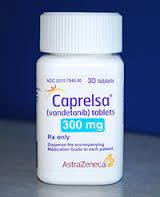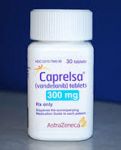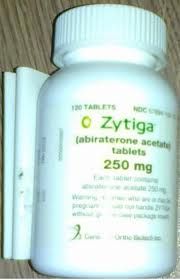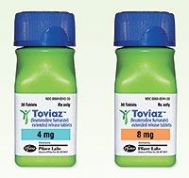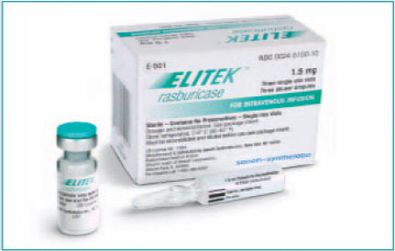罕见的甲状腺癌批准新治疗-Vandetanib是为髓样髓样甲状腺癌批准的第一个药物
美国食品和药品监督管理局今天批准vandetanib治疗没有手术资格和疾病正在生长或引起症状晚期(转移)髓样甲状腺癌成年患者。
甲状腺癌是位于颈部甲状腺的癌样生长。髓样甲状腺癌累及在甲状腺内发现的特殊类型细胞和可能自发,或作为遗传综合征的一部分发生。
按照美国国立癌症研究所资料,在美国2010年期间约诊断44,600新甲状腺癌病例,而约1,690人死于该疾病。髓样甲状腺癌被估计代表所有甲状腺癌的百分之3至5;在美国其估计发生率对2010年约约1,300至2,200例患者,使它成为甲状腺癌的较罕见型之一。.
髓样甲状腺癌的常见症状可能包括咳嗽,吞咽困难,甲状腺肿大,颈部肿胀, 甲状腺上肿块,和人声音变化或嘶哑。
Vandetanib靶向髓样甲状腺癌生长和扩张的能力。对这种类型癌当前没有FDA-批准的治疗。在每天基础上口服给予Vandetanib。
在一项331例晚期髓样甲状腺癌患者单个,随机化国际研究确定Vandetanib的安全性和有效性。研究中患者被选择接受vandetanib或安慰剂(糖丸)。
研究被设计成测量无个体癌进展的患者生存时间长度(无进展生存)。接受vandetanib患者当与接受安慰剂患者比较时有较长的无疾病进展时间期。安慰剂组中位无进展生存为16.4个月和vandetanib组至少22.6 个月确定。用vandetanib治疗患者中位无进展生存或告诉他们是否会比用安慰剂治疗患者活得更长(总体生存)是太早了。
药物评价和研究中心肿瘤药品室主任Richard Pazdur, M.D说:“Vandetanib批准强调FDA批准治疗罕见和难治疾病患者的承诺。”
来自使用vandetanib发生的常见副作用包括腹泻,皮疹,恶心,高血压,头痛,疲乏,食欲减退,和胃(腹)痛。研究期间报道的延长副作用导致用vandetanib治疗患者死亡5例。死亡原因包括呼吸并发症,心衰,和血中细菌感染(败血症)。
Vandetanib被显示影响心脏电活动,其中某些病例可能引起不规则的心跳可能导致死亡。Vandetanib正在被批准一项评价风险和减灾[Mitigation]策略(REMS)告知医疗保健人员关于这些严重心脏相关风险。只有经vandetanib REMS计划,一个限制分配计划,认证的卫生保健人员和药房将能开处方和发放药物。患者也将接受一个经FDA-批准的药物指南知道药物潜在风险。
Vandetanib由阿斯利康AstraZeneca Pharmaceuticals公司上市 LP of Wilmington, Del。当前本药还没有商品名。
2011年4月6日,美国食品和药品监督管理局批准vandetanib片(Vandetanib片,AstraZeneca Pharmaceuticals LP),一种激酶抑制剂,为有不可切除,局部进展,或转移疾病有症状或进展髓样甲状腺癌患者的治疗。因为vandetanib治疗相关风险,在有惰性,无症状或缓慢进展疾病患者中vandetanib的使用应谨慎仔细考虑。
批准是根据一项有不可切除局部进展或转移髓样甲状腺癌患者中进行的国际,多中心,随机化,双盲试验。患者被随机化(2:1)接受或vandetanib,300 mg/day口服,(n=231)或安慰剂(n=100)。主要目的是证实用vandetanib与安慰剂比较无进展生存(PFS)的改善。其它终点包括d的评价总体生存(OS)和客观缓解率(ORR)。在评估PFS和ORR中采用一种集中,独立盲态审评影像资料。根据由研究者客观疾病进展,患者接受开放给予vandetanib的选择。.
随机化至接受vandetanib患者观察到PFS改善(HR=0.35;95% CI: 0.24, 0.53; p<0.0001)。纳入前6个月内或有症状或有疾病进展子组分析中显示相似PFS结果:分别为风险比0.31(95% CI:0.19, 0.53)和0.41 (95% CI:0.25,0.66)。主要PFS分析时,15%患者已死亡;未注意到显著OS差别。对随机化至接受vandetanib或安慰剂患者ORR分别是44%相比1%。所有客观缓解是部分缓解。
黑框警告包括QT延长,尖端扭转型室性心动过速[torsades de pointes],和骤死。因为vandetanib的19天长半衰期,在基线,在开始治疗后2-4周和8-12周及随后每3个月应得到ECGs和血清钾,钙,酶和TSH水平。经受腹泻患者中可能需要更经常监查电解质和ECGs。只有经Vandetanib风险评价减灾战略计划认证的处方者和药房才能开处方和发配vandetanib。
最常见(≥20%)1-4级不良反应包括腹泻/结肠炎,皮疹,痤疮样皮炎,恶心,高血压,头痛,疲乏,食欲减退,和腹痛。>20%患者中实验室异常包括钙减低,增加ALT,和葡萄糖减低。最常见(≥ 5%)3-4级不良反应是腹泻/结肠炎,高血压和高血压危象,QT延长,疲乏,和皮疹。导致接受vandetanib患者(n=5)死亡不良反应是呼吸衰竭,呼吸停止,吸入性肺炎,有心律失常心脏衰竭,和败血症。此外,注意到在数据截止期后两例接受vandetanib患者死亡(一例骤死和一例死于心肺停止)。
Vandetanib的推荐每天剂量为300 mg口服。有中度(肌酐清除率 ≥30 to <50 mL/min)和严重(肌酐清除率 <30 mL/min)肾受损患者中起始剂量应减低至200 mg。
批准日期:April 6, 2011年4月6日;公司:阿斯利康公司AstraZeneca
初始美国批准:2011
一般描述
为口服给予的(Vandetanib)片有两种规格,100 mg和100 mg,分别含100 mg和300 mg的Vandetanib。片中含以下无活性成分:片芯:二水磷酸氢钙,微晶纤维素,交聚维酮,聚乙烯吡啶酮,和硬脂酸镁。片的包膜含以下无活性成分:hypromellose 2910,macrogol 300,and titanium dioxide E171。
Vandetanib在化学上描述为N-(4-Bromo-2-fluoroanilino)-6-methoxy-7-[(1-methylpiperidin-4-yl)methoxy]quinazolin-4-amine
结构和分子式为:

C22H24BrFN4O2
Vandetanib的分子量为475.36。Vandetanib表现pH-依赖溶解度,在低pH时增加溶解度。Vandetanib实际上不溶于水在25°C(77°F)时溶解度值为0.008 mg/mL。
作用机制
Vandetanib是一种激酶抑制剂。体外研究曾显示Vandetanib抑制剂酪氨酸激酶包括表皮生长因子受体(EGFR),血管生长因子受体(VEGFR),转染期间重排(RET),蛋白激酶6(BRK)的成员,TIE2,EPH受体激酶家族的成员,和酪氨酸激酶Src成员的活性。在体外血管生成模型中Vandetanib抑制内皮细胞迁移,增殖,生存和新血管生成。Vandetanib抑制在肿瘤细胞和内皮细胞中表皮生长因子(EGF)-刺激的受体酪氨酸激酶磷酸化和内皮细胞中VEGF-刺激的酪氨酸激酶磷酸化。
在体内在小鼠肿瘤模型中Vandetanib给药减低肿瘤细胞-诱导血管生成,肿瘤血管通透性,和抑制肿瘤生长和转移。
没有RET突变和Vandetanib疗效相互关系的证据。
适应证和用途
Vandetanib是一种激酶抑制剂适用于治疗不能切除,局部晚期或转移的有症状或进展的髓样甲状腺癌。
因为vandetanib治疗相关风险,在惰性,无症状或缓慢进展疾病患者中使用vandetanib应谨慎小心考虑。
剂量和给药方法
(1)300 mg每天1次(2)
(2)在严重毒性事件或QTc间期延长时可能需要减低剂量(2.1)
(3)有中度和严重肾受损患者中开始剂量应减低至200 mg。
剂型和规格
100 mg和300 mg片(3)
禁忌证
有长QT综合征患者不要使用vandetanib。
警告和注意事项
(1)曾报道延长的QT间期,尖端扭转型室性心动过速和骤死。在基线,开始vandetanib治疗后2-4周和8-12周,和其后每3个月及剂量调整后,监查心电图和血清钾,钙和TSH水平。当剂量减低适当(2.1,5.1)
(2)曾观察到Stevene-Johnson综合征导致死亡。严重皮肤反应可能促使永远终止vandetanib(2.1,5.2)
(3)曾报道间质性肺疾病征导致死亡。中断vandetanib和研究不能解释呼吸困难,咳嗽,和发热。为间质性肺病应采取适当测量(2.1,5.3)
(4)曾观察到缺血性脑血管事件,出血,心衰,腹泻,甲状腺低下症,高血压,和可逆性后脑白质脑病综合征(2.1,5.4,5.5,5.6,5.7,5.8,5.9,5.10)
(5)当vandetanib给予妊娠妇女可能致死。建议妇女当接受vandetanib和治疗后4个月时避免妊娠(5.14,8.1)
(6)因为QT延长,尖端扭转型室性心动过速和骤死的风险,只能通过严格分配计划被称为vandetanib REMS计划得到vandetanib。只有经认证的处方者和药房能够处方和分配vandetanib。通过电话1-800-236-9933或访问www. Vandetanibrems.com知道关于特殊REMS的要求和纳入vandetanib REMS计划(5.15)
不良事件
用vandetanib最常见药物不良反应(>20%)曾是腹泻,皮疹,痤疮,恶心,高血压,头痛,疲乏,食欲减退和腹痛。最常见实验室异常(>20 %)是钙减低,ALT升高,和葡萄糖减低(2.1,5.2,5.7,5.9,6.1)
为报告怀疑不良反应,联系AstraZeneca Pharmaceuticals LP电话1-800-236-9933或FDA电话1-800-FDA-088或www.fda.gov/medwatch。
药物相互作用
与已知强CYP 3A4诱导剂同时使用可能减低vandetanib药物水平而应避免(7.1)。Vandetanib与强CYP 3A4抑制剂伊曲康唑[itraconazole]未显示临床意义药物相互作用(7.2)。避免vandetanib与可能延长QT间期药物给药。
如何供应/贮存和处置
100 mg片- 可得到含30片瓶(NDC 0310–7810–30).
300 mg片- 可得到含30片瓶(NDC 0310–7830–30).
贮存和处置
Vandetanib片应贮存在25°C (77°F);外出时允许至15°C – 30°C (59°F – 86°F)[见USP 控制室温]。
曾发表几个指导原则[1-4]。 Vandetanib片不应被压碎。应避免皮肤和粘膜不要直接接触压碎片。如发生这类接触,如同参考资料彻底冲洗。人员应避免暴露至亚碎片。
 |
CAPRELSA can prolong the QT interval and cases of Torsades de pointes and sudden death were reported in clinical trials. Because of this risk, CAPRELSA is only available through the CAPRELSA Risk Evaluation and Mitigation Strategy (REMS) Program. Read more.
The CAPRELSA REMS Program has the following specific goals:
To educate prescribers about the risk, appropriate monitoring, and management of QT prolongation to help minimize the occurrence of Torsades de pointes and sudden death
To inform patients about the serious risks associated with CAPRELSA
Indication
CAPRELSA is a kinase inhibitor indicated for the treatment of symptomatic or progressive medullary thyroid cancer in patients with unresectable locally advanced or metastatic disease.
Use of CAPRELSA in patients with indolent, asymptomatic or slowly progressing disease should be carefully considered because of the treatment related risks of CAPRELSA.
Important Safety Information, including boxed WARNING
| WARNING: QT PROLONGATION, TORSADES DE POINTES, AND SUDDEN DEATH CAPRELSA can prolong the QT interval. Torsades de pointes and sudden death have been reported in patients receiving CAPRELSA. CAPRELSA should not be used in patients with hypocalcemia, hypokalemia, hypomagnesemia, or long QT syndrome. Hypocalcemia, hypokalemia and/or hypomagnesemia must be corrected prior to CAPRELSA administration and should be periodically monitored. Drugs known to prolong the QT interval should be avoided. If a drug known to prolong the QT interval must be administered, more frequent ECG monitoring is recommended. Given the half-life of 19 days, ECGs should be obtained to monitor the QT at baseline, at 2-4 weeks and 8-12 weeks after starting treatment with CAPRELSA and every 3 months thereafter. Following any dose reduction for QT prolongation, or any dose interruptions greater than 2 weeks, QT assessment should be conducted as described above. Because of the 19-day half-life, adverse reactions including a prolonged QT interval may not resolve quickly. Monitor appropriately. Only prescribers and pharmacies certified with the restricted distribution program are able to prescribe and dispense CAPRELSA. |
Do not use CAPRELSA in patients with congenital long QT syndrome.
Because of the risk of QT prolongation, ECGs and levels of serum potassium, calcium, magnesium, and TSH should be monitored at baseline, at 2-4 weeks and 8-12 weeks after starting treatment with CAPRELSA, and every 3 months thereafter and following dose adjustments.
Severe skin reactions (including Stevens-Johnson syndrome), some leading to death, have been reported and may prompt permanent discontinuation of CAPRELSA.
Interstitial lung disease (ILD) has been observed with CAPRELSA and deaths have been reported. Interrupt CAPRELSA treatment and investigate unexplained dyspnea, cough, and fever.
Ischemic cerebrovascular events, serious hemorrhagic events, and heart failure have been observed with CAPRELSA and some cases have been fatal.
Diarrhea has been observed with CAPRELSA. Serum electrolytes and ECGs should be carefully monitored in cases of diarrhea because of the risk of QT prolongation with CAPRELSA. If severe diarrhea develops, CAPRELSA treatment should be stopped until diarrhea improves.
Hypothyroidism, hypertension, and reversible posterior leukoencephalopathy syndrome (RPLS) have been observed with CAPRELSA.
The concomitant use of known strong CYP3A4 inducers may reduce drug levels of CAPRELSA and should be avoided. The administration of CAPRELSA with antiarrhythmic drugs and other drugs that may prolong the QT interval should be avoided.
CAPRELSA exposure is increased in patients with impaired renal function. The starting dose of CAPRELSA should be reduced to 200 mg in patients with moderate to severe renal impairment and the QT interval should be monitored closely.
CAPRELSA is not recommended for patients with moderate and severe hepatic impairment, since safety and efficacy have not been established.
CAPRELSA can cause fetal harm when administered to a pregnant woman. Women of childbearing potential should be advised to avoid pregnancy while receiving CAPRELSA and for at least 4 months following treatment.
The most common adverse drug reactions (>20%) seen with CAPRELSA are diarrhea (57%), rash (53%), acne (35%), nausea (33%), hypertension (33%), headache (26%), fatigue (24%), decreased appetite (21%), and abdominal pain (21%). The most common laboratory abnormalities (>20%) were decreased calcium (57%), increased ALT (51%), and decreased glucose (24%).
CAPRELSA REMS Program: Because of the risks of QT prolongation, Torsades de pointes and sudden death, CAPRELSA is available only through the CAPRELSA REMS Program. Only prescribers and pharmacies certified with the restricted distribution program are able to prescribe and dispense CAPRELSA. To learn about the specific REMS requirements and to enroll in the CAPRELSA REMS Program call 1-800-236-9933 or visit


